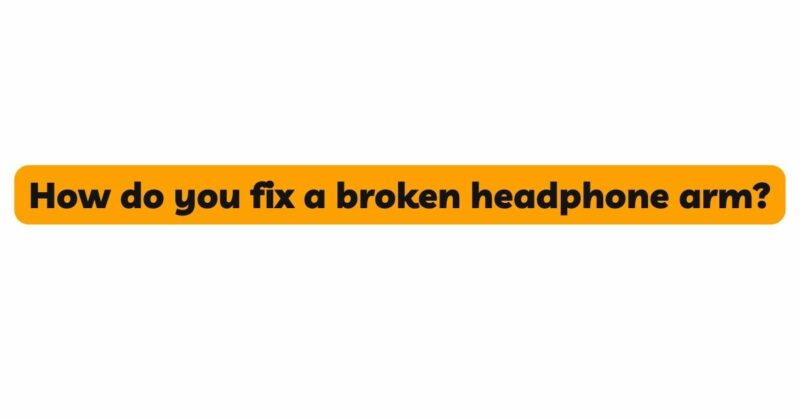Headphones are essential accessories for music lovers, gamers, and professionals alike. However, constant use and wear can lead to common issues, such as a broken headphone arm. A broken arm not only impairs comfort but also compromises audio quality. Fortunately, repairing a broken headphone arm is often a straightforward process that can save you the cost of buying a new pair. In this article, we will explore step-by-step methods to fix a broken headphone arm, along with valuable tips to prevent future damage.
- Diagnosing the Issue:
Before diving into the repair process, it’s essential to diagnose the problem accurately. Examine your headphones to identify any visible cracks, fractures, or disconnections in the arm. Ensure that the issue is indeed with the arm and not any other part of the headphones. If you find any loose or disconnected wires, take note of their positions as this information will be crucial for the repair.
- Gathering the Tools:
To fix a broken headphone arm, you’ll need some basic tools, including:
a) Screwdriver set (usually Phillips or Torx) b) Soldering iron and solder c) Wire stripper d) Heat shrink tubing e) Super glue or epoxy adhesive f) Electrical tape
- Disassembling the Headphones:
Most headphones are designed to be easily disassembled for repairs or replacement of parts. Begin by removing any cushions or pads on the earcups. Next, look for screws or clips that secure the headphone’s housing. Use the appropriate screwdriver to loosen and remove these screws gently. Once the housing is open, carefully disconnect the headphone cables from the broken arm.
- Repairing the Broken Arm:
Depending on the extent of the damage, there are various repair methods for fixing a broken headphone arm:
a) Gluing: If the arm has a clean break and fits together neatly, using super glue or epoxy adhesive can be sufficient. Apply the adhesive to both sides of the break and press them together, ensuring a firm bond. Be cautious not to get glue inside the headphones, as it could damage the internal components.
b) Splinting: For more severe breaks or fractures, you can use a small piece of thin plastic or metal as a splint. Align the broken pieces of the arm and secure the splint to the top and bottom of the arm using super glue or epoxy. This method provides additional reinforcement and stability to the repair.
c) Soldering: If the arm is connected to a hinge or swivel mechanism and has detached at the joint, soldering might be necessary. Use a soldering iron to heat the joint and reattach the arm to its original position. Make sure to match the wires correctly based on your notes from the initial diagnosis.
- Strengthening the Repair:
To ensure the longevity of your repair, it’s essential to strengthen the fixed headphone arm:
a) Reinforce with Heat Shrink Tubing: After the adhesive or soldering has set, cover the repaired area with heat shrink tubing. Shrink the tubing using a heat gun or a hairdryer to create a protective layer around the break, enhancing durability.
b) Wrapping with Electrical Tape: As an extra layer of protection, you can wrap the entire arm with electrical tape. This will safeguard against further stress or bending and prevent wires from accidentally getting detached.
- Reassembling the Headphones:
With the arm repaired and strengthened, it’s time to reassemble the headphones. Reconnect any cables that you had to disconnect during the disassembly process. Align the housing correctly and secure it in place using the screws or clips. Finally, reattach any cushions or pads that were removed earlier.
- Testing the Repaired Headphones:
Before celebrating the successful repair, it’s crucial to test the headphones thoroughly. Plug them into a device and play some audio to ensure that both sides of the headphones are working correctly. Also, check if the repaired arm remains stable and comfortable during use.
Conclusion:
Repairing a broken headphone arm might seem intimidating at first, but armed with the right tools and knowledge, it is a feasible task for many users. By diagnosing the issue correctly and following the appropriate repair method, you can salvage your beloved headphones and extend their lifespan significantly. Remember, prevention is better than cure, so take care of your headphones, avoid excessive bending or twisting, and store them properly when not in use to reduce the risk of future damage. Happy listening!


